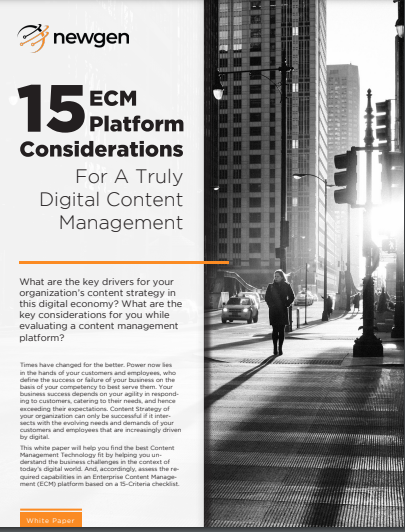Why Content Management Is Business-Critical Today?
Modern customers and employees expect seamless, instant access to information anywhere, anytime, and on any device. Yet many organizations still rely on outdated, rigid Enterprise Content Management (ECM) systems that slow down processes, frustrate users, and increase compliance risk.
This whitepaper explains how the ECM market has evolved into content services platforms – agile, modular, and cloud-ready systems that support digital transformation. It provides a practical 15-point checklist for business and IT leaders evaluating ECM solutions to enable faster, smarter, and more customer-centric operations.
Drivers for Modern Digital Content Management
Traditional ECM approaches no longer meet the needs of digital customers and employees. Organizations face five key pressures pushing them to modernize:
- Demand for Instant, Omnichannel Experiences
Customers expect consistent, seamless interactions across web, mobile, chat, social, and branch — with any content type (documents, videos, images, messages) accessible instantly. - Boundaryless Work and Secure Collaboration
Employees, partners, and vendors need mobile, cross-platform access to content while maintaining security and governance. - Elasticity and Agility
Businesses must respond quickly to market changes — scaling up or down and integrating innovative solutions without long IT cycles. - Breaking Silos for Holistic Operations
Disconnected systems create friction and inefficiency. Teams need interconnected content services that can integrate with CRM, ERP, BPM, and other core applications. - Tighter Compliance and Governance
New regulations and stricter data privacy rules require granular control, audit trails, and secure information management.
From Legacy ECM to Content Services Platforms
Analyst insights (from Gartner, Forrester, AIIM) show the shift from monolithic ECM to microservices-based content services. Instead of one-size-fits-all, modern platforms are modular, API-driven, and business-friendly.
This approach enables organizations to:
- Rapidly build customer-centric apps that embed content in business workflows.
- Deploy updates faster without disrupting existing systems.
- Reduce costs while improving agility and user experience.
The 15-Point Checklist for Choosing an ECM Platform
To enable true digital transformation, an ECM platform should deliver these core capabilities:
- Multi-channel Content Management
Capture, process, and deliver content across web, mobile, email, social, and print for a seamless customer journey.
- Contextual Analytics
Mine and analyze content and data for actionable insights, enabling faster and more personalized customer response.
- Accurate, First-Time-Right Content Capture
Eliminate rework and delays by capturing and validating content correctly at the first touchpoint.
- High-Speed Capture, Storage & Access
Support real-time transactions for the front office and bulk content operations for the back office.
- Automated Workflows
Map and automate operational processes to improve customer response time and reduce manual work.
- Robotic Process Automation (RPA)
Automate repetitive tasks such as data entry and file classification to boost speed and accuracy.
- Business & Process Monitoring
Provide dashboards, KPIs, and alerts for real-time tracking and continuous improvement.
- Repository Agnostic Access
Enable a single, virtualized view of all content across multiple repositories to avoid duplication and complexity.
- Integration-Friendly Architecture
Support easy API-based integration with CRM, ERP, BPM, and third-party apps to build connected business operations.
- Compliance & Governance
Embed records management, retention policies, and regulatory checks to ensure data security and legal readiness.
- User-Centric Low-Code Modularity
Empower business users to create and reuse content-driven apps quickly without heavy IT dependency.
- Enterprise-Wide, Secure Mobile Access
Allow employees and field workers to access and manage content safely across devices with encryption and multi-factor authentication.
- Deployment Flexibility
Offer hybrid, cloud, or on-premises deployment with microservices architecture for fast upgrades and zero downtime.
- Transparent Pricing & ROI Predictability
Provide clear cost structures and measurable ROI through efficiency gains, faster transactions, and better customer experience.
- Easy Upgrades & Recovery
Enable quick iteration, minimal downtime, and no single point of failure thanks to modular microservices.
Steps to Build a Future-Ready Content Strategy
- Identify and prioritize the processes and customer journeys to digitize.
- Map integrations with core systems like ERP, CRM, and BPM.
- Determine the content services you need to support these processes.
- Evaluate whether your existing ECM can evolve or a new platform is needed.
- Plan deployment incrementally — modernize without disrupting current operations.
- Enable user training and change management to drive adoption.
- Track ROI and refine continuously.
How Newgen Enables Digital Content Management?
NewgenONE Digital Transformation Platform empowers enterprises to move beyond legacy ECM with:
- Content capture, storage, and management across channels and formats.
- Advanced analytics and AI for insights and automation.
- Seamless integration with business-critical apps and partner ecosystems.
- Compliance and security at the core, with audit-ready records management.
- Low-code flexibility for rapid app development and user-driven innovation.
Trusted by global leaders in banking, insurance, government, and shared services, Newgen helps organizations accelerate digital transformation and deliver connected, agile operations.
Business Impact of a Modern ECM Platform
Organizations that adopt content services platforms see measurable improvements:
- 50% faster processing of customer requests
- 40% lower operational costs through automation and reduced manual handling
- Stronger compliance and security with centralized governance
- Faster time-to-market for new products and digital services
Start Your Content Transformation Journey
If your current ECM system is limiting agility and customer experience, it’s time to modernize.

